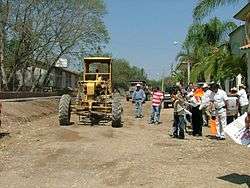Lázaro Cárdenas, Jalisco
| Lázaro Cárdenas | ||
|---|---|---|
|
The inauguration of Lázaro Cárdenas' highway. | ||
| ||
| Nickname(s): Cárdenas | ||
| Coordinates: 20°26′30″N 103°58′08″W / 20.44167°N 103.96889°W | ||
| Country |
| |
| State |
| |
| Municipality | San Martín de Hidalgo | |
| Established | April 9, 1937 | |
| Government | ||
| • Type | Municipal Agency | |
| • Municipal Agent | Bertha Alicia Hernandez Guardado | |
| • Sub-agent | Jose Isac Ramos Ruelas | |
| Elevation | 1,325 m (4,348 ft) | |
| Population (2010) | ||
| • Total | 297 | |
| Time zone | Central Standard Time (UTC-6) | |
| • Summer (DST) | Central Daylight Time (UTC-5) | |
Lázaro Cárdenas, (Spanish ![]() [ˈlasaɾo ˈkardenas] ) also known as Cárdenas, is a town in the municipality of San Martín de Hidalgo in the Mexican State of Jalisco.
[ˈlasaɾo ˈkardenas] ) also known as Cárdenas, is a town in the municipality of San Martín de Hidalgo in the Mexican State of Jalisco.
History
Prior to 1937, the area was known as Rancho 'El Camichín', a land grant owned by Jesús Rosas. The land was donated by Rosas with the purpose of constructing a townsite. Many of the people residing in the nearby town of San Jerónimo, migrated to acquire lands in the town. The town was officially established with a document[1] signed on April 9, 1937 by the governor and residents dictating that the new name would be "Lázaro Cárdenas", in honor of Lázaro Cárdenas del Río, President of Mexico from Michoacán (1934–1940).
After the farmers settled, they built temporary grass huts known as chosas,[2] and later constructed permanent adobe homes. At first, the townsite resembled a long isosceles triangle which was called la manga, or "the sleeve". The town is conveniently located between Ipazoltic and San Martín de Hidalgo, the municipal seat.
Population
As of the INEGI census of 2005, there were 235 people residing in Lázaro Cárdenas. 115 of them being male, and 120 of them being female.
References
- ↑ The document was published on a website of the municipality, it also has many signatures of various residents of adjacent towns.
- ↑ Quintero, Valente. San Jerónimo native Anastacia Gómez moved to Cárdenas after her older brother Jacinto, bought land in the town. She said that in 1937, the town was small and many grass huts were built by the people who had lesser resources. Her brother and his wife Catarina Calderón lived in an adobe house near the farther eastern end. Doña Anastacia often referred to the town as el pueblito, meaning "the little town".
External links
- http://mexico.pueblosamerica.com/i/lazaro-cardenas-47/
- http://galileo.inegi.gob.mx/CubexConnector/validaDatos.do?geograficaE=140770012


